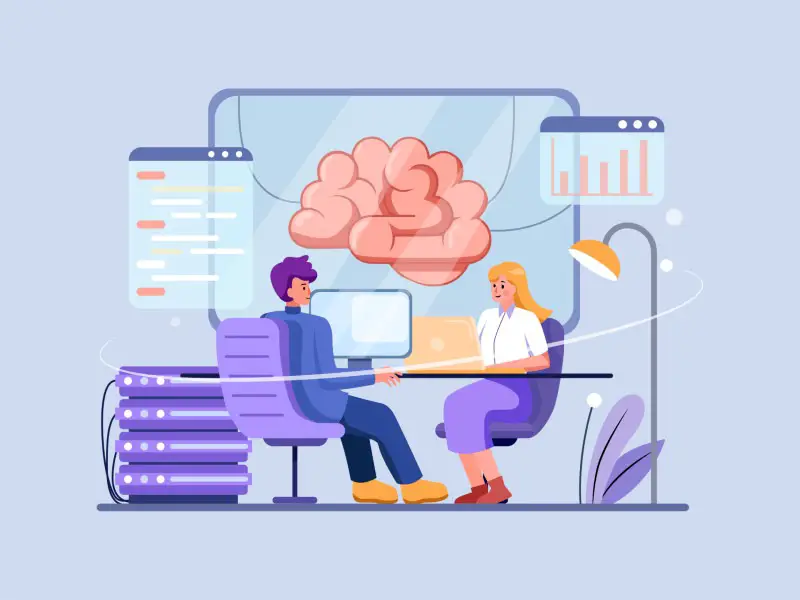When embarking on the journey of understanding artificial intelligence (AI), students and academics alike find themselves navigating an ocean of algorithms and techniques. These sophisticated strings of code form the essence of AI, propelling it from the realm of science fiction to reality. However, understanding these algorithms and techniques isn’t just about decoding lines of programming. It’s about unveiling the logic behind the code, the method in the seeming madness.
The captivating world of AI algorithms and techniques unfolds like a digital symphony. Every note and chord, from the simplest rules to the most complex machine learning models, combines to create a masterpiece of intelligence and automation. Whether you’re studying for academic purposes or seeking to unravel the enigma of AI for personal interest, this comprehensive guide is your companion in exploring AI techniques and algorithms.
In the chapters that follow, we delve into defining AI algorithms, understanding machine learning as a pivotal subfield of AI, demystifying the concept of deep learning, and detailing various AI techniques from neural networks to genetic algorithms. Each topic is carefully dissected and explained, allowing for an immersive and informative learning experience.
Defining Artificial Intelligence Algorithms: An Overview
Artificial intelligence algorithms: the heart and brain of any AI system. They form the guidelines, the rules of operation, directing an AI on how to solve problems, make decisions, and learn from experiences. These algorithms come in diverse forms, each with their unique approach and suited application.
Picture a game of chess, an environment where an AI can truly flex its algorithmic muscles. The AI would use its algorithms to scan the current state of the game, simulate future outcomes, and decide on the most promising move. Every step of this process hinges on the AI’s algorithms, each tailored to a specific task and optimized to achieve the best results.
Understanding Machine Learning: A Subfield of Artificial Intelligence
Machine Learning (ML) forms a significant subsection of artificial intelligence. It revolves around the creation of algorithms that enable machines to learn from data and make decisions or predictions. Machine Learning transitions AI from explicit programming to learning through exposure and experience, which is a game-changer in the AI industry.
Whether it’s a music app predicting your next favorite song or a spam filter ensuring your inbox remains clean, Machine Learning algorithms are the invisible forces that make this possible. They continuously learn and adapt, enabling a personalized and efficient user experience.
Deep Learning: A Subset of AI Defined
Deep Learning is a subset of Machine Learning that leverages artificial neural networks to simulate human decision-making. The term ‘deep’ refers to the number of layers in these networks. The layers enable the extraction of high-level features from raw input data, which is particularly useful in tasks such as image and speech recognition.
Consider the example of your interaction with OpenAI’s language model through the ChatGPT login. This experience is powered by deep learning algorithms, which interpret your input and generate contextually relevant responses.
AI Techniques: From Neural Networks to Genetic Algorithms
Artificial intelligence is a vast field with a range of techniques that vary in complexity and function. Neural networks and genetic algorithms are two such techniques that have found widespread use due to their versatility and efficacy.
Artificial Neural Networks (ANNs) are modeled on the human brain, with interconnected nodes representing neurons. These networks are particularly effective in pattern recognition tasks, contributing to AI advancements in areas such as speech recognition, natural language processing, and image analysis.
On the other hand, Genetic Algorithms (GAs) are inspired by the process of natural selection. These algorithms encode potential solutions to a problem as “genes,” which are then evolved over generations to find the optimal solution. They are commonly used in optimization and search problems.
Key Artificial Intelligence Algorithms and Techniques Explained
The field of AI is populated with an array of algorithms and techniques, each with its unique abilities and applications. Let’s look at some of the key ones.
Decision Trees, for instance, are simple yet powerful tools for decision-making and classification problems. By breaking down a dataset into smaller subsets while at the same time an associated decision tree is incrementally developed, they provide a roadmap for reaching a decision. They’ve found application in various fields, from machine learning and data mining to customer relationship management.
Support Vector Machines (SVMs), on the other hand, are more specialized. They’re used for classification and regression analysis, and they work well even when the data points are not linearly separable. An SVM classifies data by finding the hyperplane that maximizes the margin between the classes in the data.
Let’s also not forget about Reinforcement Learning algorithms. These algorithms are all about learning optimal behaviors through interaction with the environment and receiving feedback in the form of rewards or punishments. The driving principle here is to learn from past actions and rewards to make better future decisions. Think of a chess-playing AI that improves over time by learning from its wins and losses.
Finally, the Convolutional Neural Networks (CNNs) and Recurrent Neural Networks (RNNs) deserve a special mention for their transformative role in deep learning. CNNs, best suited for processing grid-like data such as images, have largely powered the recent advancements in computer vision. RNNs, on the other hand, excel in tasks that involve sequential data, making them invaluable in areas like natural language processing and speech recognition.
In the end, each of these algorithms and techniques serves a purpose, solving problems and making decisions that push the boundaries of what AI can achieve.
Which of the following industries commonly requires data entry tasks?
Conclusion
Exploring the vast expanse of AI techniques and algorithms is akin to undertaking a thrilling expedition into the depths of human ingenuity and innovation. From understanding the very definition of AI algorithms, diving into the subfields of machine learning and deep learning, to unraveling various AI techniques like neural networks and genetic algorithms, we have embarked on an enlightening journey into the heart of artificial intelligence.
The seemingly abstract concepts of AI find tangible expressions in everyday applications, personalizing our music, protecting our inboxes, and even conversing with us through AI-powered chatbots. Behind each of these interactions lie sophisticated algorithms and techniques that breathe life into artificial intelligence.
While we’ve delved deep into some areas, like Machine Learning and Deep Learning, and skimmed over others, it’s crucial to remember that this is just the tip of the AI iceberg. With the rapid advancements in AI, the landscape of AI algorithms and techniques is ever-evolving, continually offering new frontiers to explore and understand.
The future of AI is exciting and brimming with potential. And as we stride forward, armed with our understanding of AI’s core techniques and algorithms, we are better equipped to harness this potential and shape the future. After all, understanding is the first step in mastery. The code, once mastered, unfolds endless possibilities.
Whether you’re a student diving into AI for the first time or an academic striving to stay at the forefront of AI advancements, remember, every line of code you decipher, every algorithm you understand, brings us one step closer to unraveling the enigma that is AI.

AI: A Green Revolution in the Agricultural Landscape
Artificial Intelligence is fueling a new Green Revolution, transforming agriculture with precision farming, sustainable practices, and smarter pest control. Discover how AI is shaping the future of farming, creating a sustainable, efficient, and productive agricultural landscape




